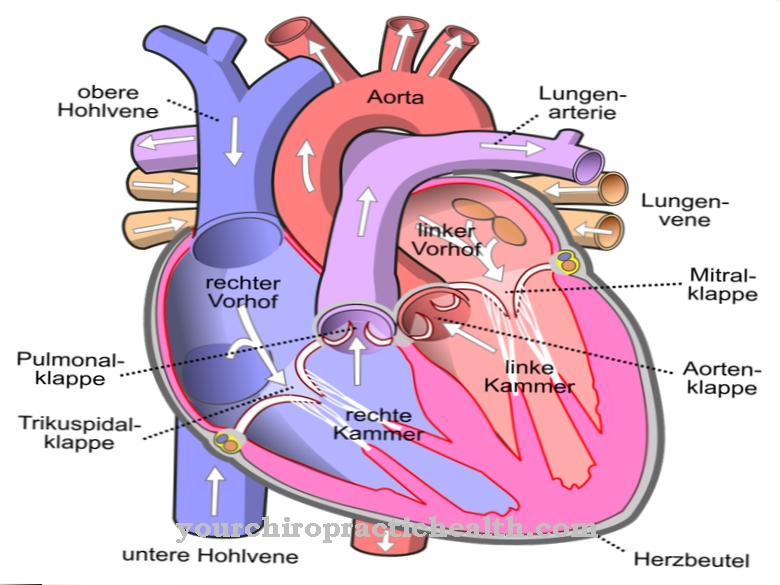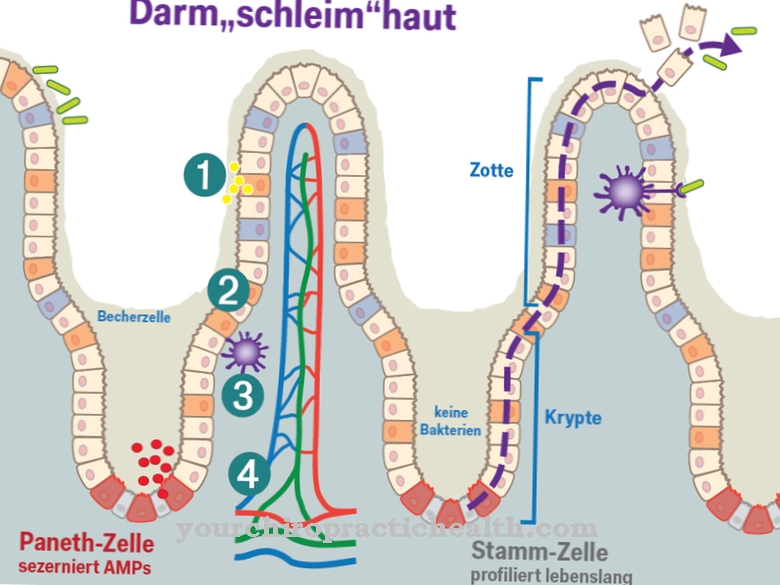Of the Hypothalamus is a comparatively small but vital tissue area of the autonomic nervous system. The hypothalamus regulates the production of various hormones that, among other things, stimulate the pituitary gland.
What is the hypothalamus?

Of the Hypothalamus belongs to the diencephalon (diencephalon) and coordinates the blood pressure as well as the water and salt balance within the autonomic nervous system as a superordinate control center.
The important control center of the human organism is located below ("hypo") the thalamus, the largest tissue structure of the diencephalon. The hypothalamus can be divided into an anterior, medullary, and posterior, medullary section.
While the anterior section is responsible for vegetative functions and acts as an interface between the nervous and internal secretory systems, the posterior hypothalamus is assigned to the limbic system.
Location, anatomy & structure
Of the Hypothalamus is demarcated upwards from the dorsal thalamus by a shallow furrow within the wall of the 3rd ventricle. The hypothalamic nuclear areas are located in the diencephalon walls below this groove.
Towards the forehead, the optic chiasm (optic nerve junction) is located at the base, behind which the infundibulum (funnel-like structure) descends on the interbrain floor. At the end of the infundibulum is the pituitary gland. At the transition to the midbrain further back, the corpora mamillaria protrude from the hypothalamus floor on both sides. The posterior hypothalamus, which belongs to the limbic system, consists primarily of the corpora mamillaria and is traversed by large, medullary nerve fibers (axons of the fornix) (medullary hypothalamus).
On the other hand, thinner nerve fibers run through the anterior hypothalamus (hypothalamus with few piths). This can also be divided into many individual core areas (several dozen) that belong to the vegetative system. In addition, the anterior hypothalamus contains a large number of receptors to which the hormones synthesized by other endocrine glands can bind.
Function & tasks
The anterior, medullary arm Hypothalamus serves as an endocrine gland and the receptors and nerve fibers it contains as a kind of interface or mediation point between hormonal and nervous regulation of different body functions.
The suprachiasmatic nucleus located above the optic nerve junction generates the internal clock and the individual day-night rhythm via direct inputs from the retinal ganglion cells, via which information from the environment (including time of day) is supplied. The nucleus supraopticus as well as the nucleus paraventricularis, which are located in the area of the ventricle or optical tract, represent further important hypothalamic nuclei. Here endocrine neurons (glandular nerve cells) produce important hormones for the organism such as ADH (antidiuretic hormone) and oxytocin.
ADH has a reducing effect on the amount of urine excreted, which also regulates the feeling of thirst. Oxytocin is a hormone that triggers labor at the end of pregnancy and is increasingly released during orgasm. Oxytocin also creates a feeling of trust and closeness. In the area of the opening of the infundibulum, the so-called tuber nuclei are located, which also act as endocrine glands inhibiting and stimulating hormones such as dopamine and somatostatin or gonadotropin-releasing hormones (GnRH), thyrotropin-releasing hormones (TRH), corticotropin-releasing - Synthesize hormones (CRH) and growth hormone-releasing hormones.
The infundibular and dorsomedial nucleus regulate food intake and metabolism. The axons draining from the hypothalamus influence the function of the internal organs via the motor nerve cells.
Illnesses, ailments & disorders
The function and mode of action of the Hypothalamus can be affected by various benign (benign) and malignant (malignant) diseases or tissue changes.
If a disease correlates with a change in the production of a hormone formed in the hypothalamus, this is usually named after the hormone concerned. If, for example, the nucleus supraopticus and accordingly the production and secretion of the antidiuretic hormone (ADH) is impaired as a result of traumatic events, bleeding, tumors or cerebral inflammation, diabetes insipidus (ADH deficiency) or Schwartz-Bartter syndrome (ADH excess ) manifest.
Long-term therapy with glucocorticoids can cause a CRH deficiency, which can lead to a glucocorticoid deficiency and then have a negative effect on the carbohydrate, protein and lipid metabolism as well as the salt and water balance. Changes in the hypothalamic tissue structures or malignant tumors in other organs can also influence CRH production and cause Cushing's syndrome (excess CRH).
Accidents, radiation therapy measures, tumors or operations can also lead to a hypothalamic dopamine deficiency via tissue changes and accordingly to a prolactin excess (hyperprolactinemia) or a TRH deficiency (hypothyroidism).
In addition, a so-called craniopharyngioma (benign brain tumor), which increases in size and presses on the hypothalamus and the pituitary gland, can damage the tissue structures of the hypothalamus and impair its functions, in particular hormone production.
























.jpg)



